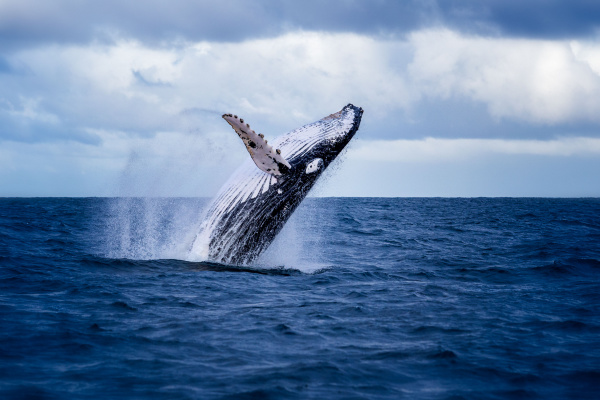The world’s largest whales are more than just astonishing creatures. As CNN reports, much like the ocean, soil and forests, new research shows that whales can help save humanity from the accelerating climate crisis by sequestering and storing planet-heating carbon emissions.
In a paper published earlier this month in the journal Trends in Ecology & Evolution, climate researchers suggest that whales are vital, but often overlooked, “carbon sinks.” The enormous size of these marine mammals, which can reach 150 tons, means they can store carbon much more effectively than smaller animals.
And because whales live longer than most animals, some for more than 100 years, the research states they could be “one of the largest stable living carbon pools” in the ocean. Even after they die, whale carcasses descend to the deepest parts of the sea and settle on the seafloor, trapping the carbon they’ve stored in their stout, protein-rich bodies.
An indirect way whales can be critical carbon sinks is through their feces. Whale poop is rich in nutrients which can be taken up by phytoplankton — tiny organisms that suck up carbon dioxide as they grow. When they die, phytoplankton also sink at the bottom of the seafloor, taking tiny bits of carbon in their carcasses.
The process of carbon sequestration helps mitigate climate change, because it locks away carbon that otherwise would have warmed the planet somewhere else for hundreds, if not thousands, of years.
But according to CNN, most whale species are threatened, with six out of 13 great whale species classified as endangered or vulnerable due to threats including industrial whaling, which has reduced whale biomass by 81%, as well as entanglement with fishing gear, climate change-induced shifts in prey availability, noise pollution and more.
Heidi Pearson, lead author and researcher at the University of Alaska Southeast, said the research shows that protecting whales has a double benefit — helping to stem the biodiversity crisis as well as human-caused climate change.
The paper puts together all available research about how whales work as critical carbon sinks. As the need grows for nature-based solutions such as tree planting to help solve the climate crisis, Pearson said it is important to understand the ability of whales to trap carbon.
“You can think of protecting whales as a low risk and low regret strategy, because there’s really no downside,” Pearson told CNN. “What if we protect them and get ecosystem benefits in addition to carbon?” She said there was no risk to this strategy compared to other untested, expensive solutions to capturing and trapping carbon, such as geoengineering. There has been much research and analysis into whales’ contribution to carbon storage over the years.
In 2019, economists with the International Monetary Fund attempted to quantify the economic benefits of whales. The first-of-its-kind analysis looked at the market price of carbon dioxide, then calculated the whale’s total monetary value based on how much carbon it captures, in addition to other economic benefits like ecotourism. It put the average value of a great whale at $2 million.
But there remain big gaps in knowledge to fully determine how whale carbon should be used in climate mitigation policies. Asha de Vos, a marine biologist and founder of Oceanswell in Sri Lanka, said it’s important to recognize that whales have “more to offer than their beauty and charisma,” and that protecting them is key to a proper functioning ocean ecosystem.
“But, as the authors suggest, we mustn’t overemphasize the role of whales in these spaces as we do not have sufficient research,” de Vos, who is not involved with the study, told CNN. “Fundamentally, whales will not save our oceans or planet on their own, but they likely play a role in the larger system.”
As Pearson continues to research whale carbon in Alaska, particularly delving into the indirect pathways in which whales can be carbon sinks, she said she hopes the current paper pushes policymakers to consider whales as a significant part of climate mitigation strategies.
It’s another layer that links the biodiversity crisis to the climate crisis — but for now, Pearson said she and a team will go back out in the field to fully quantify the carbon impact of whales.
“Whales aren’t a silver bullet to saving the planet; it’s just one small thing that we could do amidst many other things we need to do for climate change,” Pearson said. “We just need to get the scientific story straight.”
—
Photo Credit: Nico Faramaz / Shutterstock.com
